If you are not familiar with the concept of attributes, you can read our What is an attribute? article.
See your attributes
Go to Settings/Attributes, to see all the existing attributes or create a new one.
Attribute grid pagination
The attribute grid displays 25 attributes per page. To browse attributes pages, click on the page number you want to reach or use the filters.
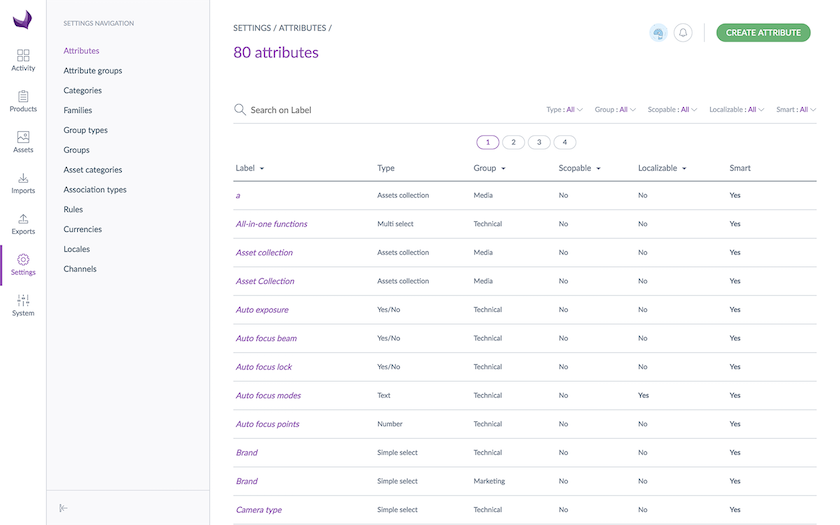
You can sort out attributes by clicking on the column header on the grid.
Search on an attribute label
To quickly find an attribute, use the search bar available above the grid. Use your attributes label to find what you are looking for.
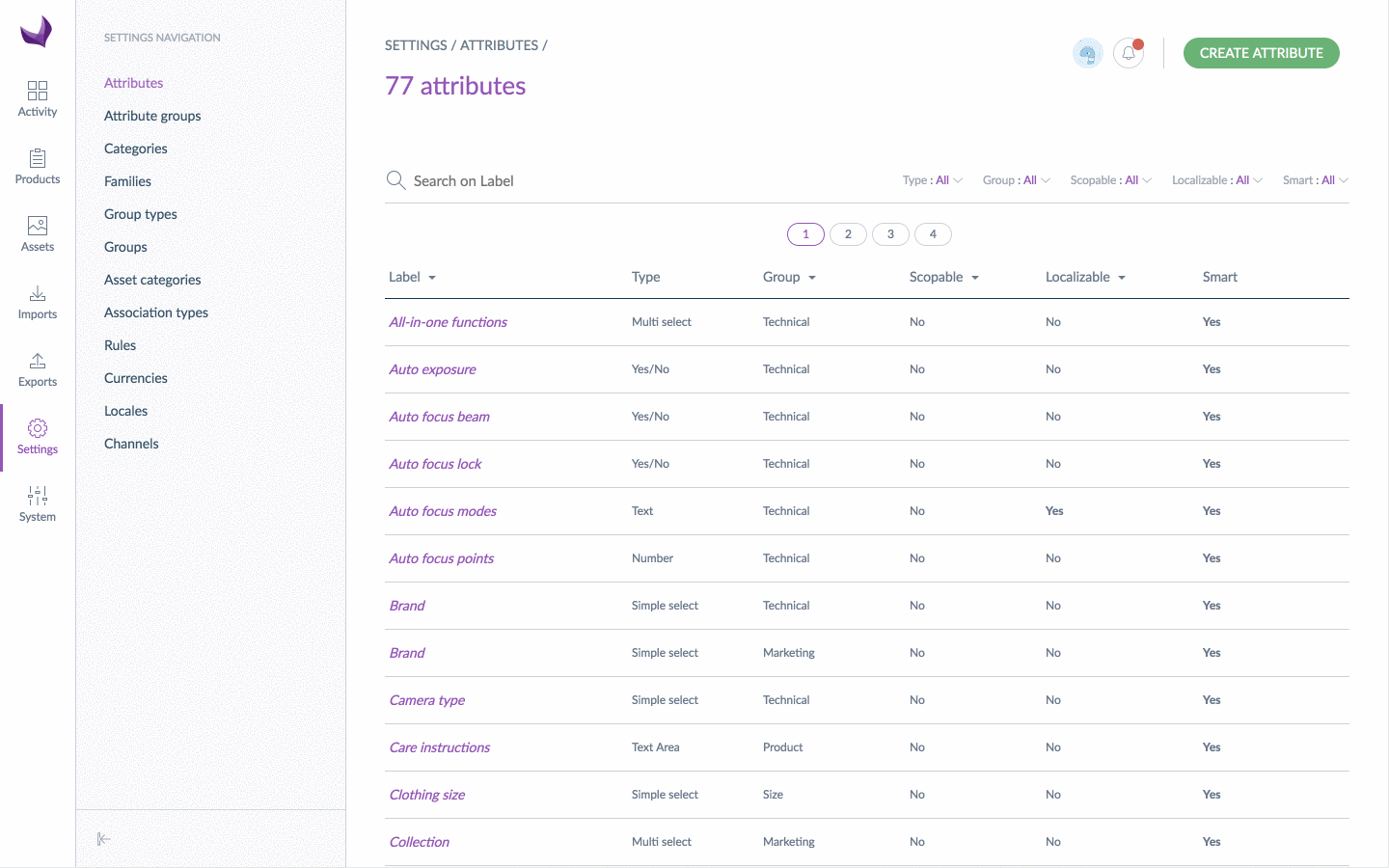
Filter on attributes
The attribute grid comes with a filter bar.
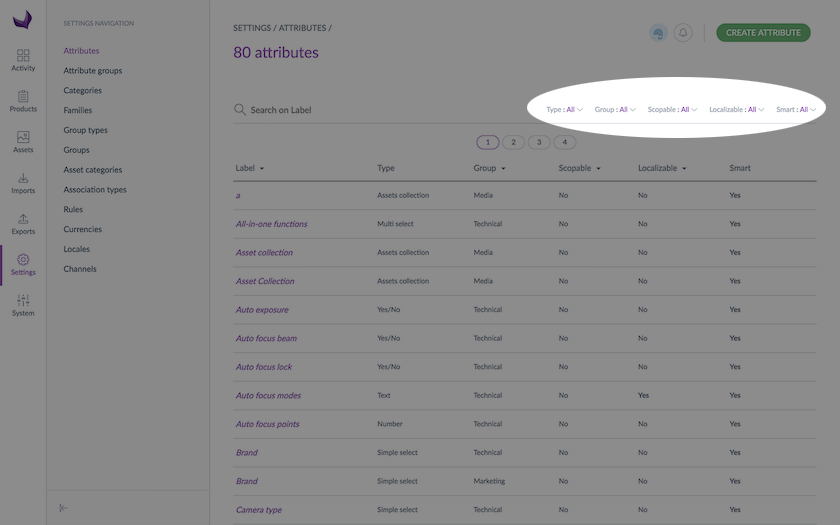
- Enter your filter criteria
- The grid is automatically updated when a new filter is set
You can filter on the following attribute information:
- The attribute type
- The attribute group it belongs to
- The
scopableproperty (one value per channel) - The
localizableproperty (one value per locale) - The
smartproperty (Yes/No) if there is a rule defined on this attribute (Enterprise Edition only)
Shortcut actions on each attribute
There is a set of actions available for each attribute. You can find on the right side of the grid. Buttons are visible when you hover your mouse over the line.
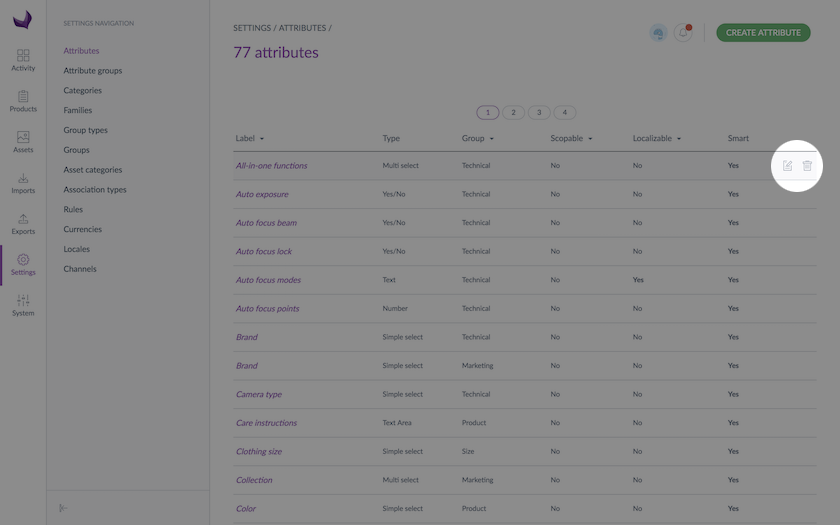
Create an attribute
Let's create an attribute! You will be able to select the most appropriate attribute type to perfectly match your needs.
For example, you can choose to create a text attribute (free text) or a drop down list (simple or multi select) with a selection of values, to make sure users will select one of the predefined options. Create a metric attribute to fill in the weight/size/length... of your products.
To create an attribute in the PIM:
- Go to
Settings/Attributes - Click on the
Create attributebutton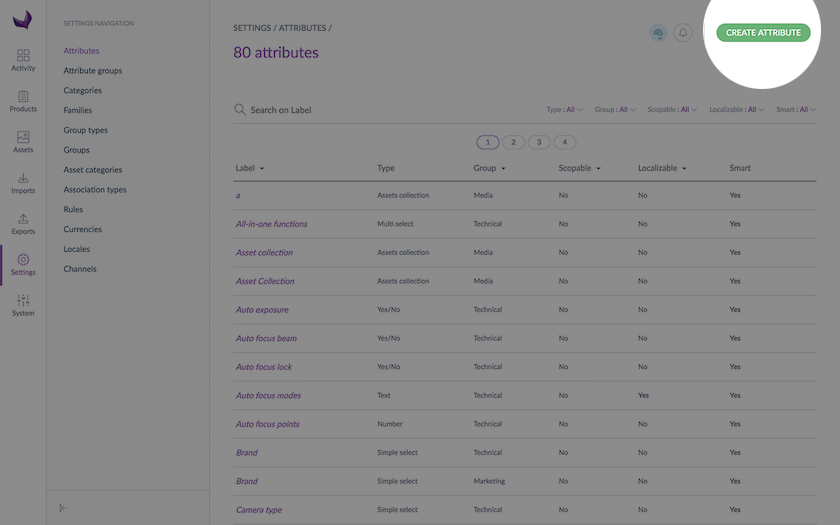
- Select the attribute type you want to create
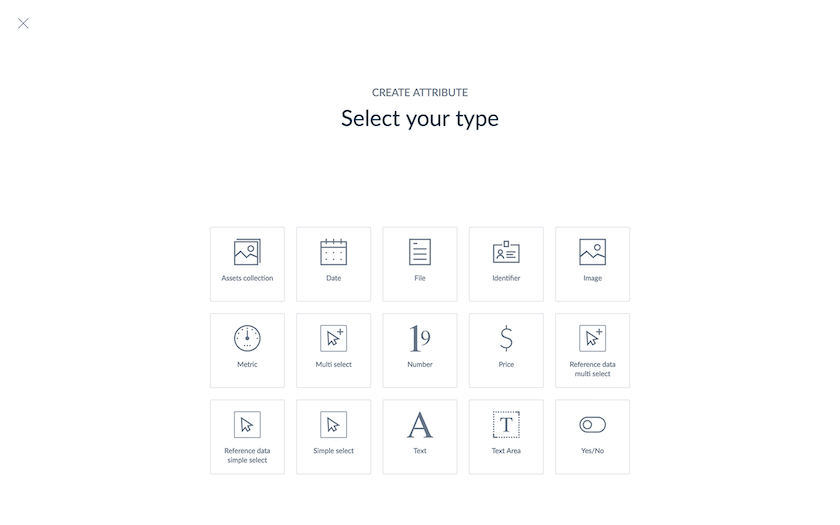
- The attribute edit page is displayed. The following properties are required to finalize the creation of your attribute:
- A code to identify the attribute
- An attribute group: the attribute group the attribute will belong to
- A unique value (Yes/No): if the value for this attribute is unique (field available or required depending on the attribute type)
- A value per channel (Yes/No): Will your product attribute values differ on the channels?
- A value per locale (Yes/No): Will your product attribute values differ on the locales?
- Locale specific: to enable this attribute only to specific locales and not all of them
- Usable in grid: whether or not the attribute can be displayed as a column or used as a filter in the product grid or in the proposal grid (EE only - since 2.2)
- Read only: when enabled it prevents this attribute from being edited through the UI, it can only be updated through imports, API or rules (Enterprise Edition only)
- Validation parameters: depending on the attribute type chosen (see Validation for the different attribute types).
- Click on
Saveto create your attribute.
The attribute is now created, you can add a translation for each enabled locales under the Label translations tab. If you need to edit some other attribute's property, please refer to the section Edit attribute properties
Each attribute has specific properties to add more control on attribute's values:
-
Date attribute:
- Min date: the earliest date that can be accepted
- Max date: the latest date that can be accepted
- A short text field: text attribute:
- Maximum number of characters: maximum number of characters that an attribute value can have
- Validation rule: how the value should be validated: such as an URL, as an Email, or using a regular expression
- A long text field: text area attribute:
- Maximum number of characters: maximum number of characters that an attribute value can have
- Enable WYSIWYG: activates the WYSIWYG feature
-
File and image attributes:
- Maximum size allowed in MB
- Allowed extensions files: png, jpg, pdf, doc, etc ...
-
Metric attribute:
- Allow negative values for the attribute
- Allow decimal values for this attribute
- Minimum value: the smallest value allowed
- Maximum value: the largest value allowed
- Metric family: family measurement unit to be used for the attribute (weight, dimensions, area, etc. )
- The default unit of measurement
-
Price attribute:
- Allow decimals for the attribute values
- minimum value: the smallest allowed value
- maximum value: the largest allowed value
-
Number attribute:
- Allow negative values for the attribute
- Allow decimals
- Minimum value: the smallest allowed value
- Maximum value: the largest allowed value
For instance, you can add a regular expression on a text field to use it for EAN codes. As they contain 13 digits, we can add a validation rule based on the following regular expression: /^[0-9]{13}$/
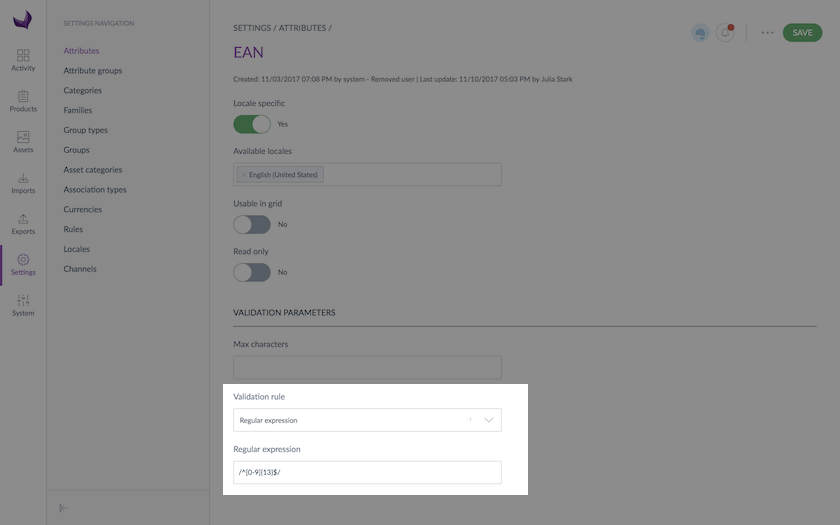
Edit attribute properties
To edit an attribute:
- Go to
Settings/Attributes - Select the attribute to edit in the grid and click on the line or on the edition shortcut
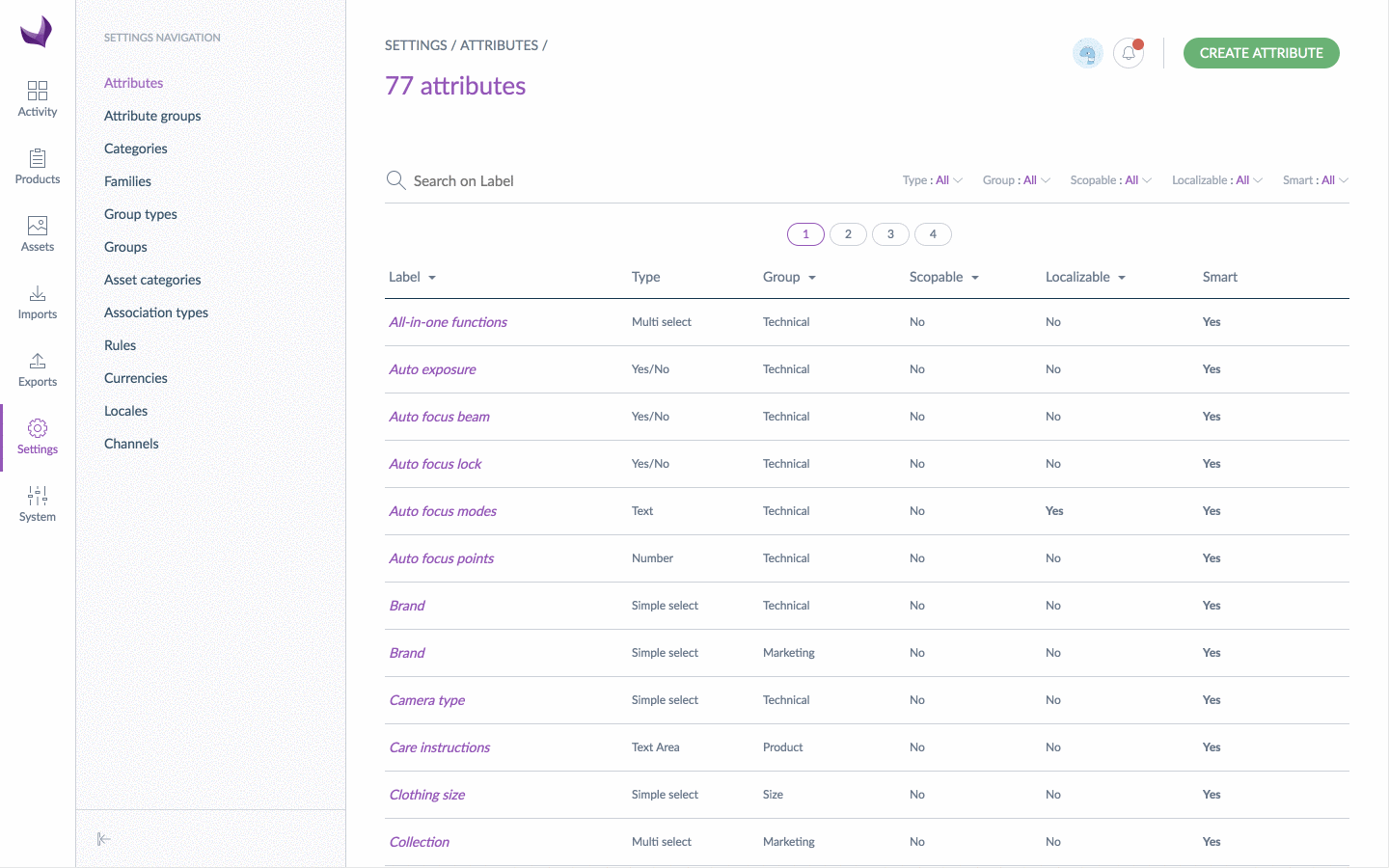
- Change the properties and click on
Save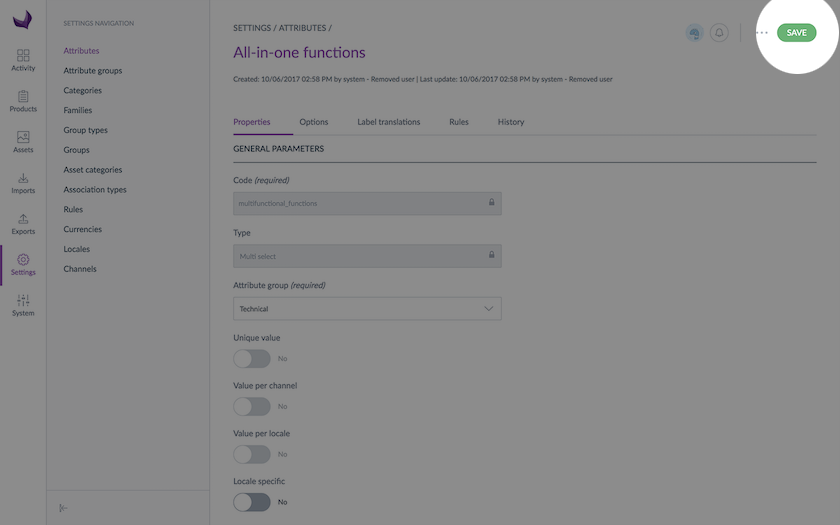
You can change the following properties of an attribute:
- Attribute group: the attribute group the attribute belongs to
- Labels: these are labels that appear when they are displayed in the PIM
- Locale specific: if it must apply to specific locales not all of them
- Usable in grid: whether or not the attribute can be displayed as a column or used as a filter in the product grid or in the proposal grid (EE only - since 2.2)
- Read only: when enabled it prevents this attribute from being edited in the UI, it can only be updated through imports or rules (Enterprise Edition only)
- Validation parameters (see Parameters according to specific attributes types)
- Options (for simple or multi select attribute types only): these are predefined values that the user can select
Manage attribute options
You can define option values for simple and multi select attribute types. Options can be added, edited, sorted or deleted.
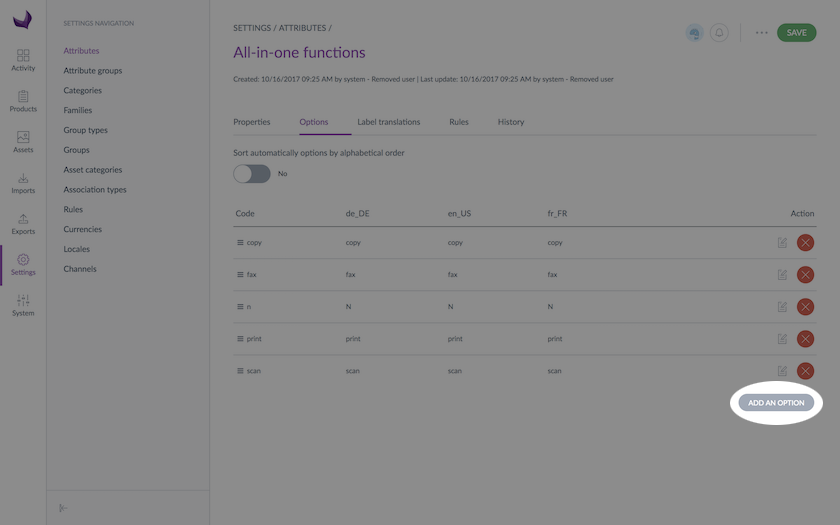
See attribute options
To see your attribute options, remove an option or add a new one:
- Go to
Settings/Attributes - Select the attribute to edit, then click on the relevant row in the attribute datagrid
- Click on the
Optionstab
Add a new option
- Click on
Add an optionbutton - Give a unique code to the new option
- Click on the green checkmark at the end of the option line to confirm the creation or on the cross to cancel the option's creation.
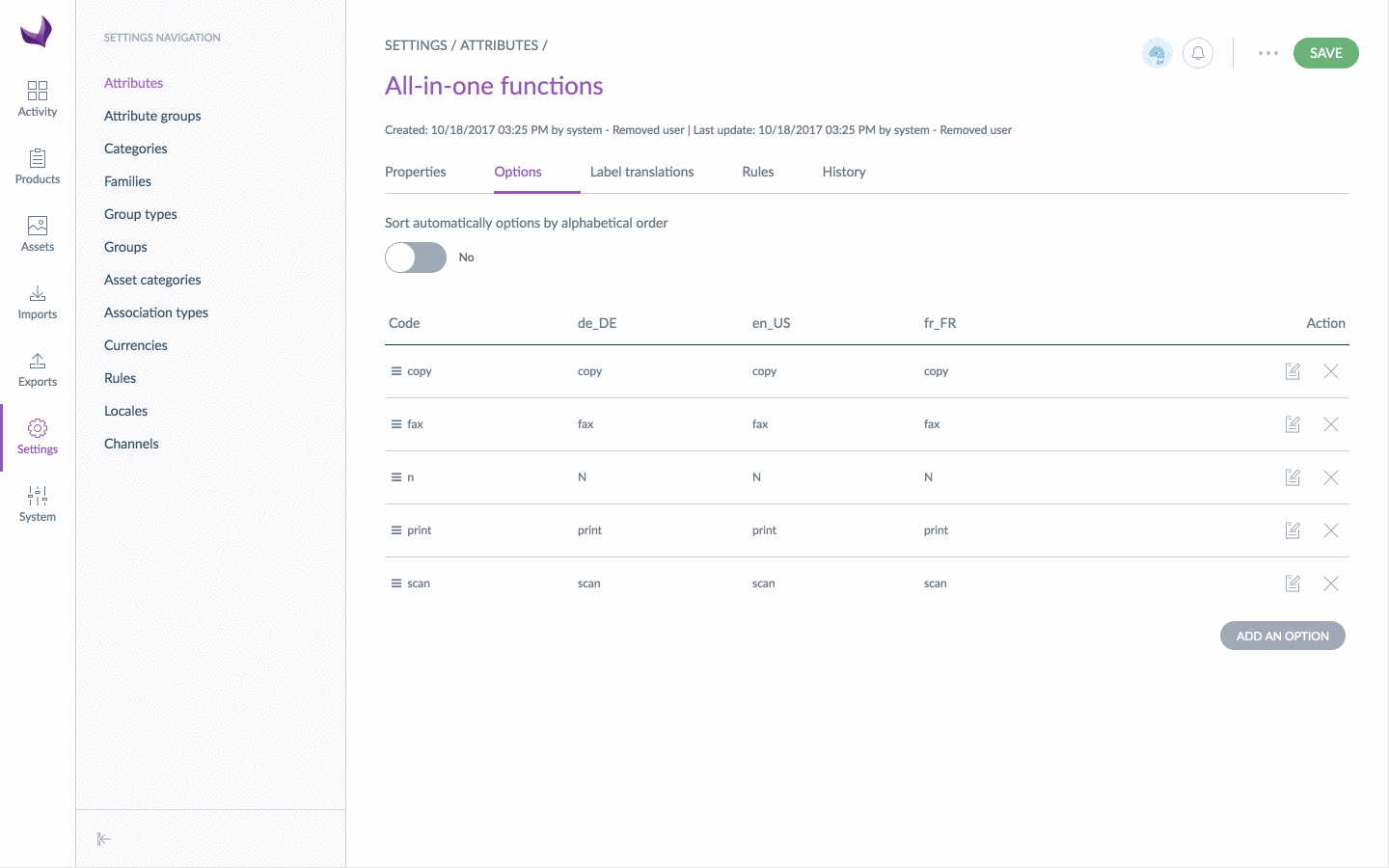
The option is instantly created.
Edit option labels
- Click on the small pencil icon change the option label(s) or code
- Click on the green checkmark to confirm or on the cross to cancel
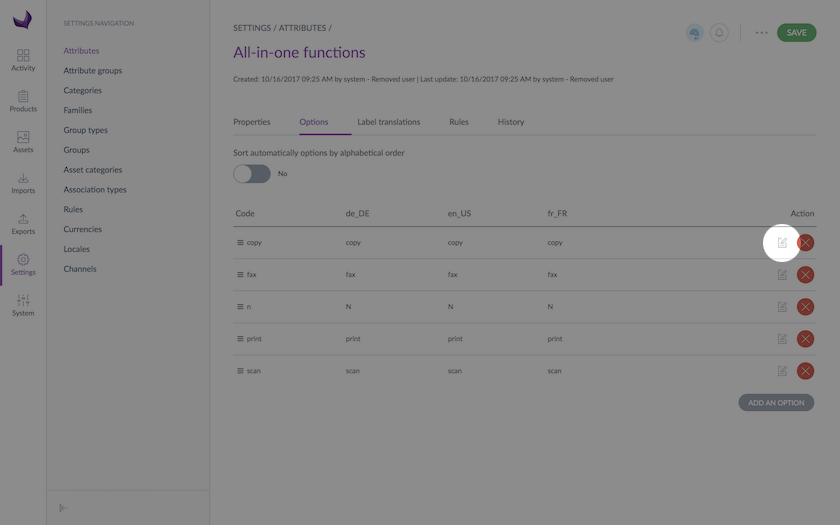
Sort out options
Options can be automatically sorted by alphabetical order using the toggle button Sort automatically options by alphabetical order on the top of the attribute's options page. If you want to define your own sort, you can drag and drop option rows to reorder options manually.
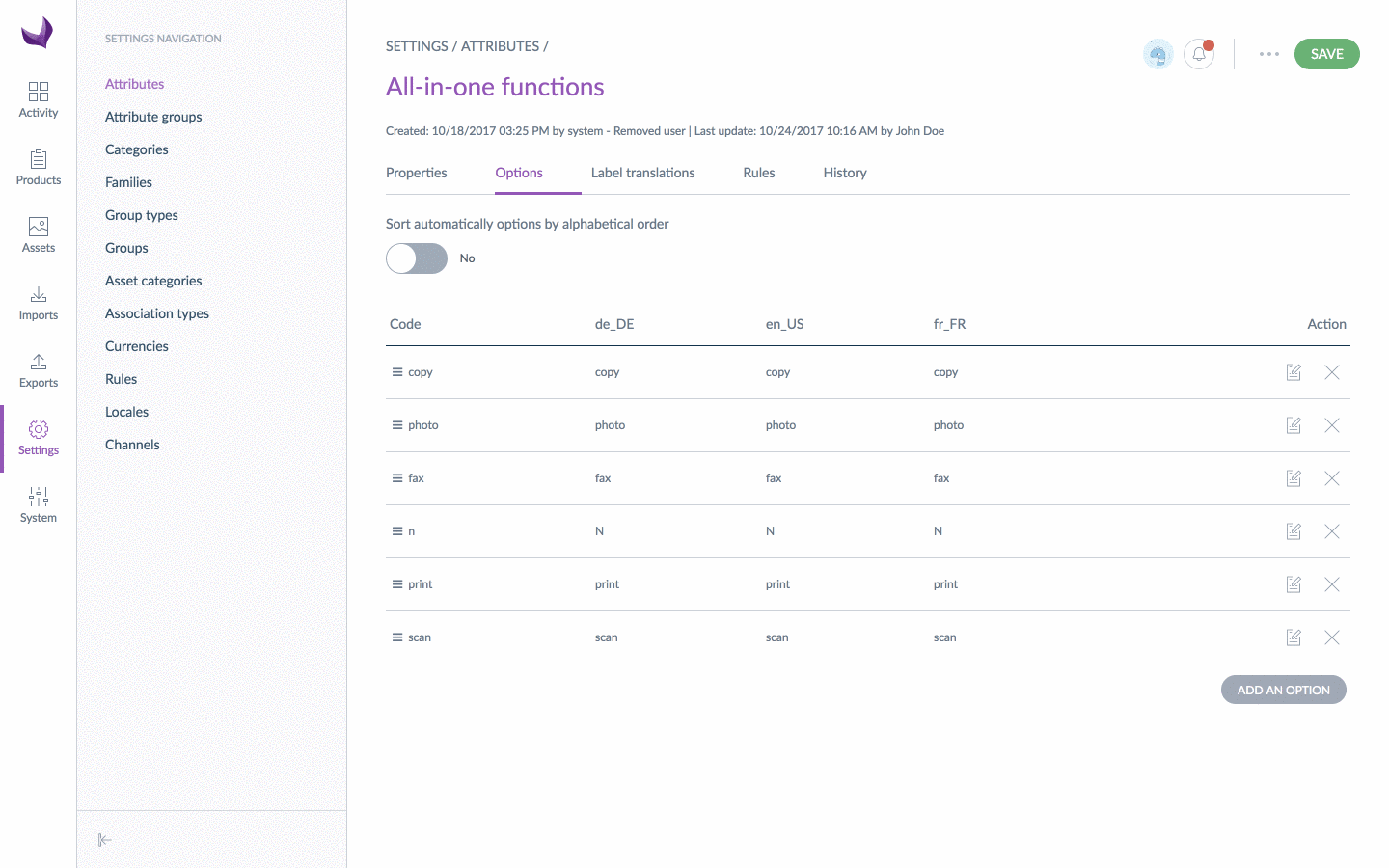
Delete an option
Click on the Delete button to remove an option
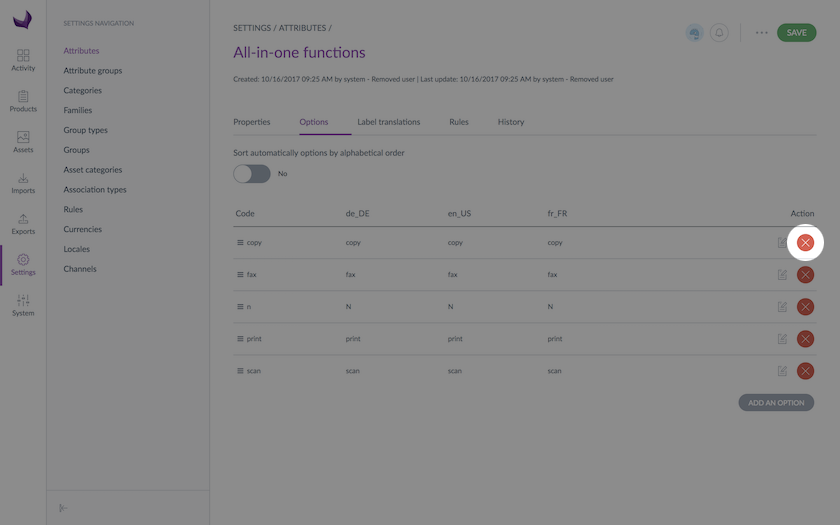
If you are not familiar with the concept of rules, you can read our What is a rule? article.
If a rule applies to your attribute, this rule will be visible under the Rules tab.
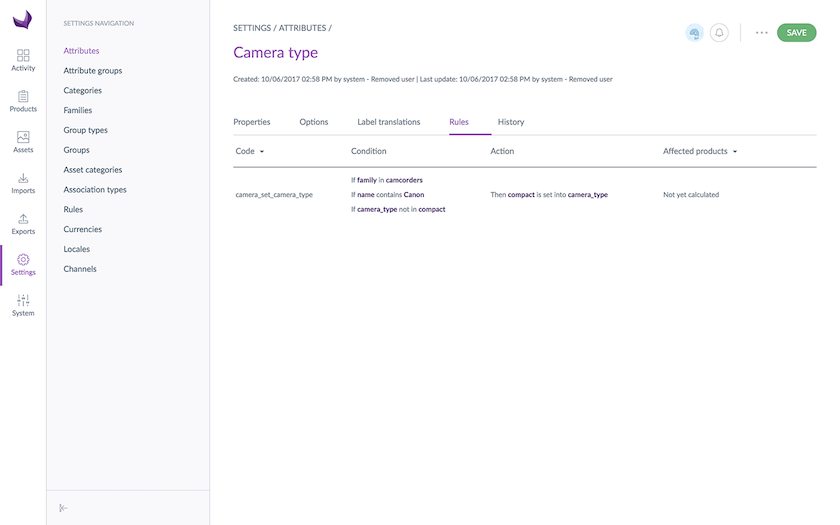
The Rules screen is composed of several information:
- Rule's code: the name of the rule imported
- Rule's condition(s): the conditions to apply the rule, starting with "If"
- Rule’s action(s): the actions to do if the product matches the condition(s), starting with "Then"
-
Number of affected products (if calculated): the number of products that are impacted by the rule (this calculation can be run from the
Settings/Rulespage, see the dedicated section Calculate the number of affected products for rules.
The rules have to be read from left to right: conditions and then actions.
Like on the Settings/Rules page, you can execute or delete rules from the Rules tab.
Check the attribute history
All changes made on attributes are saved and visible under the attribute’s history, for example: a label change, a property change, etc.
For each change, an attribute version is created. The following information is tracked down for each version:
- The person or system that made the changes
- The date and time (up to seconds) of the changes
- The old value and the new value of each modified field
To view the attribute versions:
- Open and edit the attribute page
- Click on the
Historytab and the list of version will be displayed
Delete an attribute
You have two ways to remove an attribute:
Through the attribute edit form:
- Select the attribute to delete
- Click on
...for other actions and thenDeleteon the top right corner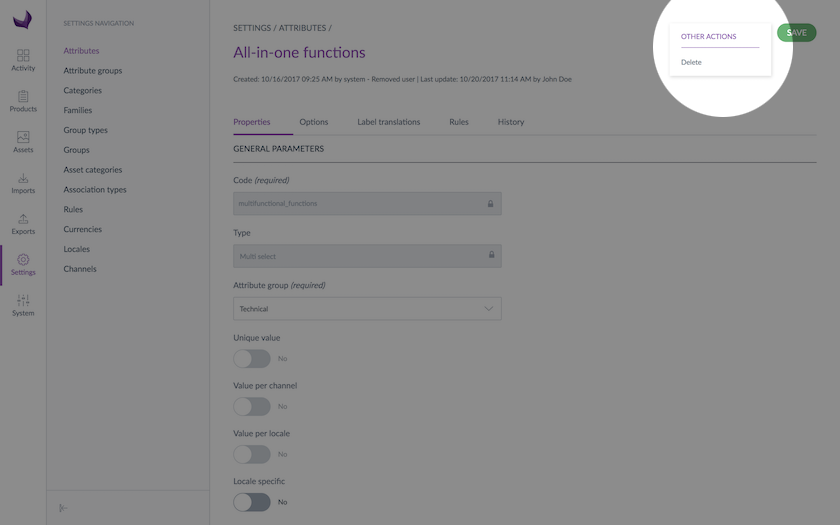
- Confirm the action in the popin
Through the Delete shortcut in the grid: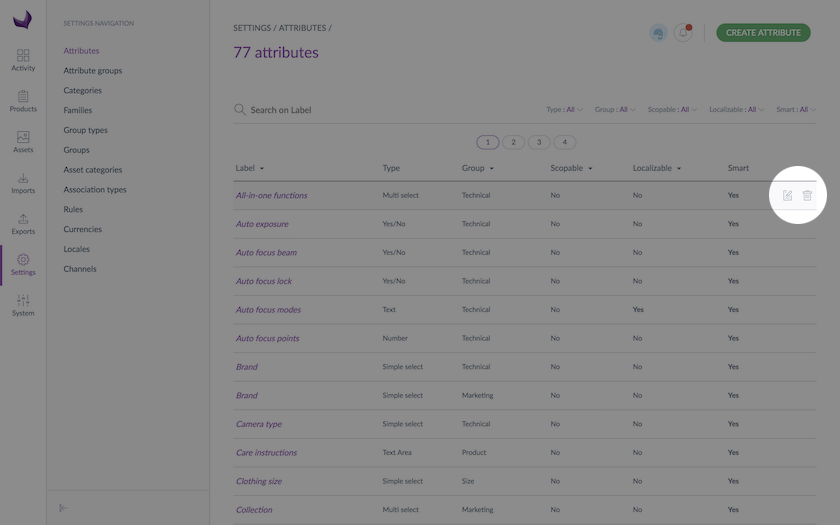
- Select the attribute you want to remove from the attribute grid
- Place your mouse over the line of attribute in the grid, the button
Deleteis prompted (trash can icon) - Click on the trash can icon
- Confirm the action in the popin
The attribute and all its relevant information will be deleted in Akeneo PIM. Once you have confirmed the action, it cannot be reverted.
